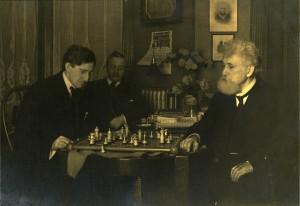
Thomas Edison called Hudson Maxim (1853-1927) “the most versatile man in America,” but, when he died, an article referred to him as a “destroyer of life.” His brother, Hiram, invented the Maxim gun, the first successful machine gun, and his nephew, also Hiram, invented a silencer to mute the sound of gunfire. But Hudson argued with them and split entirely from his brother. He was a master of self-promotion, constantly seeking (and finding) publicity. He once dressed up as King Neptune for an appearance at an Atlantic City beauty pageant. He was a leader in the development of smokeless gunpowder, but none of the companies he founded to manufacture it were ever very successful. Eventually the DuPont Company bought his patents and, along with them, his services as a consultant, setting him up in a laboratory and summer home at Lake Hopatcong, New Jersey, forty miles west of New York City. He was a prolific writer, and, later in life, a sharp social critic. He led a campaign to keep land near his New Jersey home out of the hands of developers. Ironically, around 1910, when Maxim introduced his idea for an “improvement” to the game of chess called “The Game of War,” it was reported in newspapers that he had finally come up with a “peaceful” invention!
While the main group of Hudson Maxim’s papers is in the New York Public Library, a small collection of them resides at the Hagley Museum and Library. (MSS Accession 509, 2147, 2154, PC Accessions 96.245 and 96.312.) In the photograph collection is an undated autographed picture of Hudson Maxim playing his “Game of War” with noted American chess player Frank Marshall. (There is no identification of a third gentleman who is observing, nor is there any indication of who eventually won the match.) Maxim’s changes to traditional chess included enlarging the board to be 10 squares x 10 squares, increasing the number of pieces on each side to 20, and making some of those pieces different. In ”The Game of War” there were Kings, Generals (instead of Queens), Cannon (instead of Bishops), Horse or Cavalry (Knights), Mortars (instead of Rooks), Rear and Van Troops (instead of Pawns) and, most modern of all, “Flying Machines!” (A manual for the game may be found online at http://archive.org/details/gameofwar00maxi.) Maxim remained friends with Marshall for the rest of his life, often visiting Marshall’s chess club in Manhattan to continue to promote ”The Game of War.”
Hudson Maxim, like his Game of War, is little remembered today, despite being an outstanding prototype of the late Victorian inventor, entrepreneur, and bon vivant.
Jon Williams is the Andrew W. Mellon Curator of Prints & Photographs at Hagley Museum and Library
